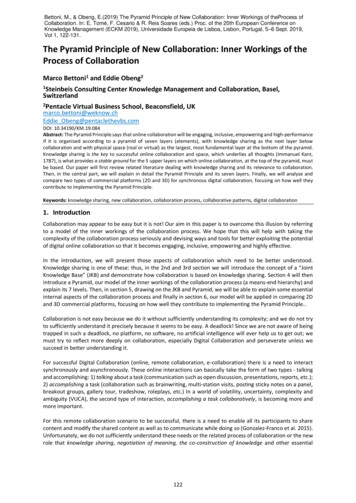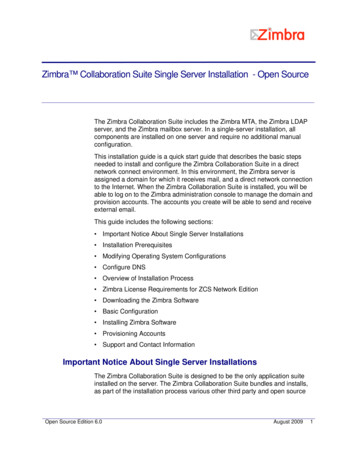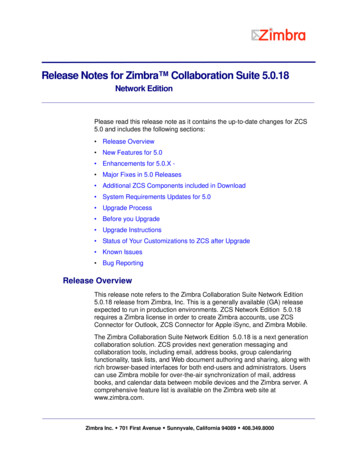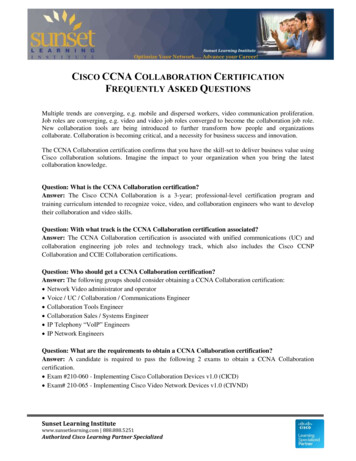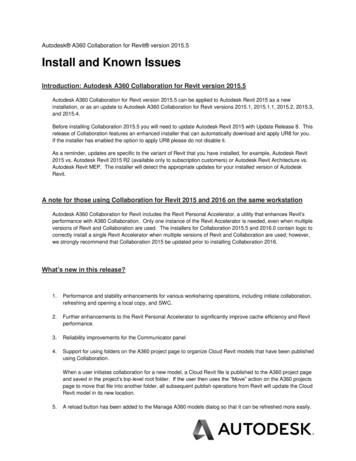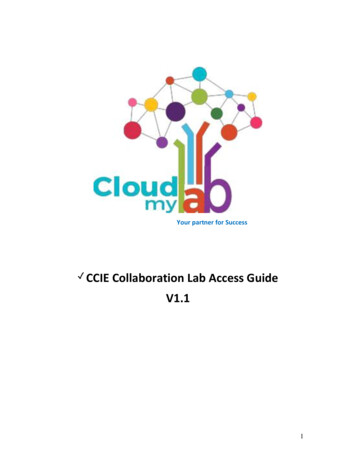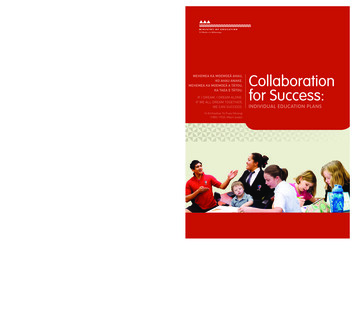
Transcription
MEHEMEA KA MOEMOEĀ AHAU,KO AHAU ANAKE.MEHEMEA KA MOEMOEĀ A TĀTOU,KA TAEA E TĀTOU.IF I DREAM, I DREAM ALONE.IF WE ALL DREAM TOGETHER,WE CAN SUCCEED.Te Kirihaehae Te Puea Hērangi(1883–1952), Māori leaderCollaborationfor Success:INDIV IDUA L ED U C AT I O N P L AN SThese resources and a download version of this booklet can befound at IEP Online www.iep.tki.org.nzIn this pocket you should find a page which details resourcesyou can use to support the information in this booklet.
The Ministry of Education thanks everybody who contributed to therevision of the Ministry of Education Individual Education Programme(IEP) Guidelines (1998).In particular, the Ministry would like to thank the sector advisorygroup: Tinirau Barlow, Anne Best, Donna Boniface, Erin Cairns,Jann Carvell, Jane Chapman, Sally Direen, Sonia Glogowski, RoseHague, Julie John, David Kennedy, Gary McClintock, Missy Morton,Tom Parsons, Judith Shearer, and Christine Zander, whose adviceand guidance have been invaluable.All weblinks contained within this book were correct at time ofpublication. The Ministry of Education takes no responsibility forsubsequent alterations to or deletions from websites.Published 2011 for the Ministry of Education byLearning Media Limited, Box 3293, Wellington 6140, New Zealand.www.learningmedia.co.nzAll text and photographs copyright Crown 2011All rights reserved. Enquiries should be made to the publisher.Dewey number 371.90993ISBN 978 0 7903 3820 0Item number 33820Visit www.iep.tki.org.nz to access: online and download versions of Collaboration for Success:Individual Education Plans a collection of tools, tips and templates which have beendeveloped by schools, parents and family/whānau andspecialist staff to support practice around the IEP process
Content at a glance1-3About this resource1.Who is this resource for?2.Purpose of the resource3.Rationale for updating the IEP GuidelinesPAGE 24Vision, policy, and principles around IEPsPAGE 45Curriculum contextPAGE 56What is an IEP?PAGE 67Who needs an IEP and when?PAGE 78Collaboration – the heart of the matterPAGE 89The IEP process – building truecollaborationPAGE 1110Assessment – what, who, and howPAGE 1411Speaking of successPAGE 1512ReferencesPAGE 16
1-3. About this resource1. WHO IS THIS RESOURCE FOR?The changes include:This resource is for anyone involved in developing orimplementing individual education plans (IEPs) tosupport students with special education needs. The New Zealand Disability Strategy, 2001 The New Zealand Curriculum, 2007 Te Marautanga o Aotearoa, 2008The audience includes: New Zealand’s ratification of the United NationsConvention on the Rights of Persons withDisabilities, 2008 the National Standards, 2009 Success for All – Every School, Every Child, 2010(the government’s vision of a fully inclusiveeducation system by 2014) the Ministry of Education’s review of literaturearound IEPs, 2010 (described below). students their parents/caregivers and members of theirwhānau, hapū, iwi, or other communities school staff, including teachers, teacher aides,and school leaders specialists.Māori-medium schools might adopt pathways differentfrom those suggested in this resource, in accordancewith their kaupapa. “Cultural differences in theperception of special needs” may be a factor (BevanBrown, 2001, page 6). However, many of the principles,especially that of collaboration, are likely to be relevant.Suggestions for collaborating with Māori communitiesare included in section 8.2. PURPOSE OF THE RESOURCECollaboration for Success: Individual Education Plansreplaces the 1998 Individual Education Programme (IEP)Guidelines (referred to as the IEP Guidelines from hereon). This new resource is intended as a compactreference to current New Zealand research, policy, andeffective practice in supporting students with specialeducation needs.For support materials, see the online version, withits collection of tools, tips, and templates, atwww.iep.tki.org.nzThe original IEP Guidelines were developed to supportthe Special Education 2000 initiative. That initiative setout to achieve a world-class education system withlearning opportunities of equal quality for all students.The relevance of Special Education 2000 remains. Wherethis new resource differs is in capturing recent findingsthat have enhanced our understanding of effectivepractices in education.3.1 LITERATURE REVIEWIn 2010, the Ministry of Education commissioned areview of the literature around IEPs to inform theirfuture use (Mitchell, Morton, and Hornby, 2010).Summary evidence from the review appears in therelevant sections of this document.The literature review focuses on: national and international developments inIEP processes assessment practices in special education3. RATIONALE FOR UPDATING THE IEPGUIDELINES research into effective, evidence-based IEPpractices.Important changes have taken place in the educationand disability sectors since the IEP Guidelines werepublished in 1998. This new resource has beendeveloped to incorporate the principles and practicalapplications of those changes. It highlights activitiesthat lead to improved student progress andachievement.The review identifies a number of positive aspects ofNew Zealand practice. However, it also notes gapsbetween the original vision for IEPs and currentimplementation.It shows that many opportunities for improvement exist.This resource aims to capture and build on thoseopportunities.PAGE 2 COLLABORATION FOR SUCCESS: INDIVIDUAL EDUCATION PLANS
COLLABORATION FOR SUCCESS: INDIVIDUAL EDUCATION PLANS PAGE 3
4. Vision, policy, andprinciples around IEPs4.1 VISION: SUCCESS FOR ALL –EVERY SCHOOL, EVERY CHILDSuccess for All – Every School, Every Child (2010) setsout the government’s vision of a fully inclusive educationsystem by 2014. Confident schools, students, parents/caregivers, whānau, and communities are at the heart ofthis vision. The IEP process needs to support this goal. The special education needs of many students canbe met by class- and school-wide strategies. Onlysome students with special education needsrequire an IEP, and few need one that capturesevery aspect of their learning. (See section 7.) Collaborative decision making is at the heart ofsupporting all students with special educationneeds. The student and their classmates, parents/caregivers, whānau, and communities aresupported to be active participants in the IEP teamand process. All educators involved in a student’slearning are included. (See sections 8 and 9.) Student engagement, learning, and achievementdepend on the relationship between the teacherand student. Language, identity, and culture count. Knowingwhere learners come from, and building on whatthey bring with them, is essential. Teachers draw on a range of effective assessmentapproaches, using the principles of assessmentfor learning. They use overall teacher judgments(OTJs) to inform teaching and learningprogrammes for all students. (See section 10.)The strategy states that all schools should be ready forall children, whatever their needs. School learningshould be a positive experience for every young person,including those with special education needs.Parents/caregivers, whānau, and communities needgood information without having to fight for it. They needto see that their child belongs, has friends, is learning,and is getting the extra help needed.4.2 POLICYThe National Administration Guidelines (NAGs) providethe policy framework for IEPs. According to the NAGs,every school must develop and implement its students’educational programmes, including those containedin IEPs.NAG 1 states:Each board of trustees is required to foster studentachievement by providing teaching and learningprogrammes which incorporate The NationalCurriculum as expressed in The New ZealandCurriculum 2007 or Te Marautanga o Aotearoa.NAG 1 goes on to require that all boards of trustees,through the principal and staff, identify and supportstudents with special education needs (NAG 1 [c] iiiand [d]).4.3 PRINCIPLESThe principles that inform IEP processes apply to allteaching and learning. They are backed up by recentresearch and extensive experience. By following theseprinciples, schools, students, parents/caregivers,whānau, and their communities can be confident thatan IEP will result in positive outcomes for all.All teaching and learning occurs within the New ZealandCurriculum and Te Marautanga o Aotearoa. Thesecurricula are relevant to all students, including thosewith special education needs. (See section 5.) The student is recognised as an active, capablelearner. IEPs are a way of adapting the schoolprogramme to fit the student rather than expectingthe student to fit the school programme. (Seesection 6.)PAGE 4 COLLABORATION FOR SUCCESS: INDIVIDUAL EDUCATION PLANS
5. Curriculum context“It [the IEP process] is about writing students intoThe New Zealand Curriculum rather than writingstudents out.”Principal quote, 2011Teaching and learning for all students in New Zealandschools, including those with special education needs,takes place within the New Zealand Curriculum andTe Marautanga o Aotearoa. These curricula are the basisof the IEP process and the criteria for judging the qualityof all teaching and learning.5.1 THE NEW ZEALAND CURRICULUM ANDTE MARAUTANGA O AOTEAROAThe New Zealand Curriculum:applies to all English-medium students irrespectiveof their gender, sexuality, ethnicity, belief, ability ordisability, social or cultural background, or geographicallocation.The New Zealand Curriculum, 2007, page 6Every aspect of the curriculum, including its vision,principles, values, and key competencies, is important.A key vision is to equip all students to be “confident,connected, actively involved, and lifelong learners”(page 8).Te Marautanga o Aotearoa states:Through the school working together with its community,whānau, hapū, and iwi, graduates of Māori-mediumschools will reach their full potential be confident topursue their own lifelong learning pathways participate positively in the community live successfuland fulfilling lives.Te Marautanga o Aotearoa, 2008, pages 2 and 3 of onlineEnglish version, page 8 of printed te reo version5.2 BALANCED PROGRAMMESSchools need to design balanced programmes for allstudents. They should explore “the natural connectionsthat exist between learning areas and that link learningareas to the values and key competencies” (The NewZealand Curriculum, 2007, page 16). Making such linkswill bring out the best ways to support students’learning and help them to reach their full potential.ADAPTATIONS AND DIFFERENTIATIONS TO THE SCHOOLAND CLASSROOM CURRICULUMFor information on using “adaptations anddifferentiations” to make the curriculum moreaccessible to students with special education needs,see section 9.3.COLLABORATION FOR SUCCESS: INDIVIDUAL EDUCATION PLANS PAGE 5
6. What is an IEP?IEP stands for “individual education plan”.The “IEP process” is the ongoing collaborative processby which IEPs are developed, implemented, andreviewed. (See sections 8 and 9.)The table below summarises what an IEP is (its keycharacteristics), contrasted by what it is not. Also seesection 9.4: “Contents of the IEP”.6.1 ADDRESSING CONFUSION AROUND IEPSThe 2010 literature review reveals that, nationally andinternationally, confusion has grown around IEPs andtheir use. It also records various barriers to effective IEPpractices, including schools: not including the student enough or payingsufficient attention to their particular goals andaspirations not involving and supporting parents/caregiversand whānau enough in the IEP process placing too much emphasis on creating IEPdocuments that are overly long and unwieldy using IEP documents as “tick box” plans instead ofembedding them in everyday practice.Teachers [in New Zealand] often viewed IEPs as anadministrative task, rather than as a tool to developmore effective instruction and learning.Mitchell et al., 2010, page 18IEPs suffer from having multiple purposes ascribed tothem, the same IEP document frequently being expectedto serve educational, legal, planning, accountability,placement, and resource allocation purposes (Mitchellet al., 2010, page 22).SOLUTIONSThe research indicates that the emphasis needs to shiftto collaboration and teaching and learning. Sections 8and 9 of this resource include various strategies forachieving effective practice. In particular, see section8.3: “Facilitating collaboration”.For more examples of effective IEP practices, see theonline collection of tools, tips, and templates:www.iep.tki.org.nzAN IEP IS AN IEP IS NOT a plan that shows how the school programme will be adaptedto fit the student a document that shows how thestudent will fit the curriculum a plan that brings together knowledge and contributions,from the student and those who best know them, about thestudent’s learning needs, aspirations, personality, andcultural background a document prepared byprofessionals to be signed off bya student’s parents/caregivers an individualised supplement to the full-class learningprogramme, which enriches the student’s classroom, school,and community experiences a different, separate curriculum a forward-looking plan that records student achievements,where they want to go, what supports are needed (includingsupport for team members), and what success might look like a document that lists barriers tolearning with no solutions a document written specifically forfunding or referral purposes a succinct outline of a few priority learning goals andstrategies to meet them within the classroom programme an exhaustive list of learning goals,activities, teaching strategies, andresources covering all the keycompetencies and learning areas a ‘living’ document that team members regularly update toreflect the student’s changing development and that the teamrefers to for guidance on their responsibilities and needs a document that is completed at ameeting and then not looked at orused until the next meetingPAGE 6 COLLABORATION FOR SUCCESS: INDIVIDUAL EDUCATION PLANS
7. Who needs an IEPand when?The special education needs of many students can bemet by class- and school-wide strategies. Only somestudents with special education needs require an IEP,and few need one that captures every aspect of theirlearning.Use IEPs only when additional teaching strategies areneeded to address a student’s particular learning goals.(See section 9.3: “Adaptations and differentiations to theschool and classroom curriculum”.) Before consideringthese alternative approaches, apply the full range ofregular teaching strategies (for example, co-operativelearning, experiential learning, buddy systems).IEPs are necessary only when: accurate and up-to-date assessment (see section10) indicates that optimal teaching and learningrequire differentiations within the New ZealandCurriculum or Te Marautanga o Aotearoa barriers to learning have been identified, requiringadaptations to regular teaching strategies or to theschool or classroom environment (see section 9.3) times of transition require extra attention toplanning, teaching, and learning.7.1 TRANSITIONSTransitions include times when a student enters school,changes class, changes school, or prepares to leaveschool. IEPs can be designed specifically for thesetransitions. When this is the case, they are sometimescalled Individual Transition Plans.The 2010 literature review states:The literature suggests that key components oftransition planning are individualised planning,active involvement of student and family members,interagency collaboration, and transition-focusedinstruction.Mitchell et al., 2010, page 227.2 IEPS IN SECONDARY SCHOOLSResearch into IEPs in secondary schools has raisedquestions around their usefulness at this level,especially because of the many teachers involved.The literature review suggests having a lead teacherwho takes responsibility for collecting assessmentsand other information from all teachers of the student.This suggestion applies across all school settings.The review also cites recent moves in the UnitedKingdom to: reduce the number of students for whom IEPsare developed focus instead on whole-school strategies formeeting special education needs (for example,by adapting regular teaching strategies) introduce the idea of “group education plans”for students with similar needs.COLLABORATION FOR SUCCESS: INDIVIDUAL EDUCATION PLANS PAGE 7
8. Collaboration –the heart of the matterThis section looks at: IEP team members (8.1) the power of collaboration – and what it dependson (8.2) facilitating collaboration, including with Māori andPasifika communities (8.3) how team members might participate in the IEPprocess (8.4).8.1 IEP TEAM MEMBERSThe 2010 literature review concluded that all thoseinvolved with the student’s learning should be part ofIEP development and implementation. Team membersmight include: the student – who is at the heart of the IEP team their parents/caregivers and members of theirwhānau, hapū, iwi, or other communities school staff, including teachers, teacher aides,and school leaders specialists.There is extensive evidence for the effectivenessof active parent involvement in improving children’sacademic and social outcomes To the maximumextent possible, students should be involved indeveloping their own IEPs.Mitchell et al., 2010, page 56Te Marautanga o Aotearoa says:For learners to succeed, the school, the home,the hapū, iwi, and community must work togetherconstantly.Te Marautanga o Aotearoa, 2008, page 2 of onlineEnglish version, page 5 of printed te reo versionTEAM SIZECollaborative problem-solving and decision-makingfocused on teaching and learning for students withdisabilities have the potential to create fundamentalchange in the ways that teachers teach and studentslearn.Mitchell et al., 2010, page 24The review adds that successful collaboration dependson factors such as:When deciding who should be involved in the team,teachers need to consider the impact of group sizeon people’s ability to participate. Too large a groupcan prevent effective input and collaboration. Toosmall a group can result in too narrow a view. It’s abalancing act. setting clear goals defining respective roles but accepting jointresponsibility for decisions and their outcomes taking a problem-solving approach establishing mutual trust and respect for oneanother’s ideas and expertise8.2 THE POWER OF COLLABORATION –AND WHAT IT DEPENDS ON being willing to learn from othersThe literature review notes the power of collaborativeways of working: aiming for consensus decision making giving and receiving feedback in an open,non-judgmental way developing procedures for resolving conflicts.PAGE 8 COLLABORATION FOR SUCCESS: INDIVIDUAL EDUCATION PLANS
Help with childcare and transport to meetingsif necessary. Provide necessary training to team members (forexample, around the IEP process, participationskills, or the student’s cultural background). Involve a meeting or hui facilitator, who might notbe part of the IEP team. Use jargon-free communication and the student’shome language as much as possible, involvinginterpreters when necessary.COLLABORATING WITH MĀORI COMMUNITIESCommunity collaboration is a fundamental concept toMāori. Partnerships with Māori communities – includingwhānau, hapū, and iwi – are often successful whenschools have an awareness of the tikanga aroundcollaboration and help community members feel safeto participate.Research into whānau views around special educationrevealed that “where services and schools have thisawareness [of tikanga] whānau are unanimouslypositive and appreciative” (Wilkie, Berryman, Himoana,et al., 2001, page 180).8.3 FACILITATING COLLABORATIONPartnerships and collaboration do not just happen.The literature review includes ideas for facilitatingcollaboration, including those below. Get to know the student’s background and maintaineffective relationships with their community beyondthe IEP process (for example, through home visitsor regular meetings).Liaise with the student, parents/caregivers,whānau, and other relevant community memberson where, when, and how the IEP should bedeveloped. Organise meetings or hui somewhere other thanat school (for example, marae, community centre,home) to discuss and develop the IEP. Before IEP meetings, provide participants withrelevant, helpful information (including questionstarters), using appropriate technology todistribute it. Ensure that meeting times do not conflict withany other commitments of team members.The same research found that “where due regard for theTreaty [of Waitangi] and the principles is in evidence,whānau can access and appreciate the resources andservices to support them with their special needschildren” (page 179). Several whānau thought thatschools and other services should “link Māori whānau with other local whānau experiencing the same orsimilar special needs. In this way, their concerns couldbe shared” (page 180).FOLLOWING THE PRINCIPLES OF THE TREATY OFWAITANGIThe literature review discussed possible use of theTe Pikinga ki Runga framework in IEP development.The framework is based on the three principles of theTreaty of Waitangi: partnership, protection, andparticipation. In particular, there is a need to pay closeattention to the unequal power relationships that canexist in any partnership Protection speaks to theimportance of both protecting and “enhancing studentself-concept and cultural identity” Participationspeaks to the importance of presence and being seenas a valued member of the classroom and learningcommunity.Mitchell et al., 2010, page 35COLLABORATION FOR SUCCESS: INDIVIDUAL EDUCATION PLANS PAGE 9
THE ROLE OF THE TEACHEROn the role of teachers, the literature review states:Teachers represent the largest and most knowledgeableresource in programming for the needs of students.The quality of their relationship with parents/carersand community agencies plays a large part in the overalloutcomes for students.Mitchell et al., 2010, page 368.4 HOW TEAM MEMBERS MIGHTPARTICIPATE IN THE IEP PROCESSHow team members participate in the IEP process willvary from one teaching and learning situation to another.For example: a classmate might suggest ideas for including thestudent at school or might support their friend atIEP meetings parents/caregivers and their communities couldhave well-established strategies forcommunicating with and supporting their child,which they could share with others a physiotherapist might identify physicaladaptations to the classroom to give the studentimproved access to learning experiences a teacher aide might keep observational data a specialist teacher could teach specific learningtasks within the classroom.COLLABORATING WITH PASIFIKA COMMUNITIESThe literature review notes “the importance ofacknowledging the cultural capital of Pasifika studentsand their families in the school setting” (Mitchell et al.,2010, page 36). Doing so may entail significant learningon the part of other IEP team members.“Pasifika people have multiple world views and diversecultural identities” (Pasifika Education Plan, 2009),including their own frameworks for collaboration.Schools need to identify and collaborate with the leadersof the specific island nations from which their studentscome. As is the case with Māori communities, workingwith parents alone is not enough. These individualsare likely to feel isolated without the support of theircommunity.The literature review notes that the face-to-face talanoamethod is a possible framework for collaboration.This Tongan method “uses traditional Pasifika valuesand rituals important to maintaining relationshipsand communication” (Mitchell et al., 2010, page 36).The Cook Islands tīvaevae model is another example.PAGE 10 COLLABORATION FOR SUCCESS: INDIVIDUAL EDUCATION PLANS
9. The IEP process - buildingtrue collaborationThis section looks at:9.2 IEP TEAM MEETINGS a diagram of the IEP process (9.1) IEP team meetings (9.2) adaptations and differentiations to the schooland classroom curriculum (9.3) contents of the IEP (9.4)IEP team meetings form only a small part of the IEPprocess, taking place especially at the “Meet and setgoals” stage of the diagram. Before meetings, membersof the team have been gathering assessment andmonitoring information. (See section 10.) implementing the IEP (9.5)DECIDING ON TEAM PROCESSES reviewing and reporting on the IEP and planningprocess (9.6).At the first IEP meeting, the IEP team decides on teamprocesses, including:For practical support materials on the IEP process, seethe online version, with its collection of tools, tips, andtemplates at www.iep.tki.org.nz communication between all members the frequency of meetings member responsibilities. (See section 8.4:“How team members might participate in theIEP process”.)9.1 DIAGRAM OF THE IEP PROCESSLike all curriculum design in New Zealand, the IEPprocess is “a continuous, cyclic process” (The NewZealand Curriculum, page 37). It brings together ateam of people closely involved with the student tocollaboratively plan a programme to meet the student’sneeds. The diagram below visualises this process.UNITMMOYC LLABORIATONLABONTHE IEPPROCESSABORIATLLLLONCOTIRACOTEACH ANDLEARNLCOIATOROMMUNITY CMEET ANDSET GOALSCOMMUNITYO CREVIEW ANDREPORTOABAt the start of the collaborative planning process, theteam (including the student if possible) needs to agreeon the IEP’s vision and primary purpose. The purposemight be classroom programme extension, alternativeeducation, or transition into or out of a classroom orschool.SETTING THE IEP GOALSTHE IEP PROCESS CANMOVE IN ANY DIRECTIONONSETTING THE IEP VISION AND PURPOSEAGREEAND PLANThe IEP team then sets goals to support the overallpurpose. The IEP team needs to: identify the student’s current strengths andsuccesses across various settings identify and agree on a few clear, achievable,measurable goals that build on current strengthsand reflect next learning steps (to a maximumof four or five goals – even having one priority goalis fine) identify a few success criteria for each goal thatshow what success might look like identify opportunities for the student to engagewith new ideas and practise new learning throughvarious tasks and settings initiate ongoing planning to support theachievement of goals, for example, adaptationsand differentiations. (See section 9.3.)OMMUNITY CCOLLABORATIONOCCURS THROUGHOUTTHE PROCESSCOLLABORATION FOR SUCCESS: INDIVIDUAL EDUCATION PLANS PAGE 11
FOCUS QUESTIONSAsking questions, such as those below, can help guidethe process of setting goals and deciding how best tomeet the student’s needs. What is important and therefore worth spendingtime on? In what ways can the classroom programme meetthe student’s educational needs and enrich theirclassroom, school, and community experiences (forexample, by supporting them to make friends)? What adaptations are necessary to the classroomor school environment? (See section 9.3.) What attitudes do we need to foster in adults andpeers to support the student? What skills or knowledge do team members needto develop? Who is going to do what?9.3 ADAPTATIONS AND DIFFERENTIATIONSTO THE SCHOOL AND CLASSROOMCURRICULUMPossible changes are grouped below under the headingsof content, teaching and learning materials, andresponses expected for students. You will need todiscuss such changes in your planning meetings (section9.2), and they are likely to feature in the IEP (section 9.4).CONTENT Leave out very complex content or present it in asimpler way. Reduce the size or breadth of the school andclassroom curriculum. Use the same activity but include IEP objectives. Overlap learning areas to help students grasp theconnections between them. Include activities that reflect the student’spreferences.TEACHING AND LEARNING MATERIALSPresent content in different ways by substituting ormodifying regular teaching materials. Provide written and visual equivalents of spokenmaterial (for example, sign language, speech-totext software, transcripts or captions for videos,diagrams and charts). Adaptations are changes to the school and classroomenvironment, teaching and learning materials, andassociated teaching strategies. These changes supportstudents to access and respond to the school andclassroom curriculum.Provide spoken or tactile equivalents of written orvisual material (for example, spoken description ofvisuals, text-to-speech software, Braille, threedimensional objects, tactile graphics). Differentiations are changes to the content of the schooland classroom curriculum and expected responses to it.These changes support students to experience success.Provide materials such as adapted computerkeyboards or alternatives to a keyboard and mouse(for example, switch access with correspondingsoftware). Use interactive web tools and social media (forexample, interactive comic strips or animations,discussion forums, chats).The 2010 literature review summarises what aresometimes called “adaptations and differentiations” tomake the curriculum more accessible (Mitchell et al.,2010, pages 64–65).PAGE 12 COLLABORATION FOR SUCCESS: INDIVIDUAL EDUCATION PLANS
RESPONSES EXPECTED FOR STUDENTSASSESSMENT AND REVIEWS Allow more time to interact with and respond tolearning materials and activities. Include a statement that identifies what hashappened since the previous IEP. (See section 9.6.) Provide opportunities for the students to expresswhat they know in multiple ways (for example,through text, speech, movement, illustration,storyboards, video, interaction with web tools). Show assessment of the student’s achievementagainst success criteria. (For more information onassessment, see section 10.) Include an agreed review date.9.4 CONTENTS OF THE IEP9.5 IMPLEMENTING THE IEPThe IEP first states its long-term vision and purpose.(See “Setting the IEP vision and purpose” under section9.2.) To support that purpose, it needs to clearly coverall the
The special education needs of many students can be met by class- and school-wide strategies. Only some students with special education needs require an IEP, and few need one that captures every aspect of their learning. (See section 7.) Collaborative decision making is at the heart of supporting all students with special education needs.

